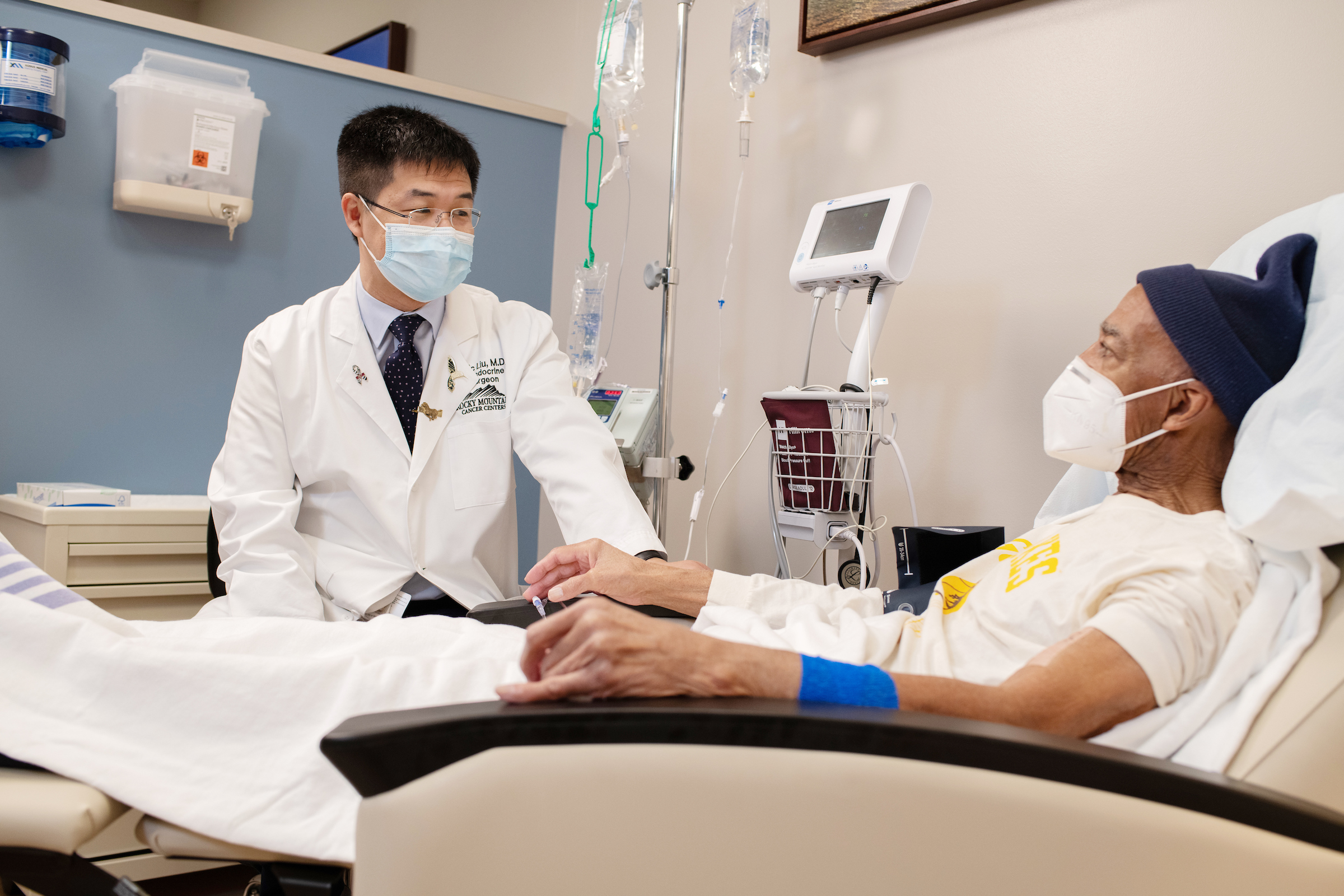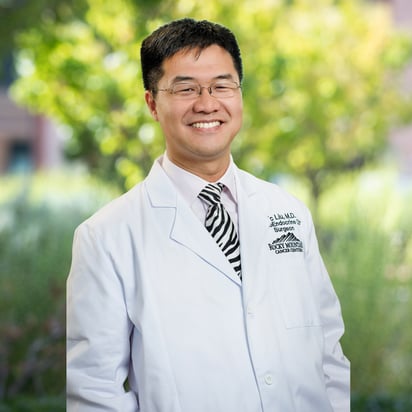Neuroendocrine Cancer Doctor Focuses on “Treating the Patient, Not the Cancer”
5 min read

A Conversation with Dr. Eric Liu, Chief Medical Director of Surgery for the Neuroendocrine Institute at Rocky Mountain Cancer Centers
Dr. Eric Liu grew up in Washington, D.C. and did the majority of his training in New York City. Five years ago, he came to Colorado to join Rocky Mountain Cancer Centers, bringing world-class expertise in Neuroendocrine tumors and related imaging technology – plus a passion and likeability that appeals to patients. He spearheaded the launch of Rocky Mountain Cancer Centers’ new Nuclear Oncology Center, opening in early 2021.
Interviewer: How do most neuroendocrine tumors get discovered?
 Dr. Liu: Very interesting question. Neuroendocrine cancer is defined as “rare,” but really, it’s a very unusual disease. It can appear anywhere in body where there are endocrine or hormone-producing cells, and it can affect people differently. The most common place of origin is in the lungs, intestines, and pancreas.
Dr. Liu: Very interesting question. Neuroendocrine cancer is defined as “rare,” but really, it’s a very unusual disease. It can appear anywhere in body where there are endocrine or hormone-producing cells, and it can affect people differently. The most common place of origin is in the lungs, intestines, and pancreas.
I co-created a foundation, The Healing NET, to address the scarcity of information about neuroendocrine cancer – both in the public and in the medical field. Our mascot is a Zebra because of how different it is in every person. Some patients have no symptoms, and the cancer gets discovered during some unrelated treatment or exam. Some people have symptoms but it’s hard to pinpoint the specific cause. The unusual symptoms of neuroendocrine cancer often leads to improper diagnosis or significantly delayed diagnosis. Additionally, physician knowledge about neuroendocrine cancer is often limited or outdated.
Interviewer: Why did you choose neuroendocrine cancer as your specialty?
Dr. Liu: The specialty chose me. I did my training in New York City and had done a lot of research on neuroendocrine. After I finished my training, the chairman of surgery at Vanderbilt Medical School called me because he was interested in starting a neuroendocrine center there. He sent me and my family to Uppsala University in Sweden to study at the best neuroendocrine center in the world for four months. One big project that I worked on was new imaging technology, Gallium DOTATAPE PET/CT (aka NETSpot, which uses imaging in combination with a dye tracer that’s absorbed by neuroendocrine tumors). I was the first physician in US to use it. Now that it’s FDA-approved, RMCC is one of the top clinics in the US for use of NETSpot. It’s a huge advancement for treatment and diagnosis of neuroendocrine cancer.
Interviewer: You’ve said that neuroendocrine tumors, in particular, need to be approached in a multidisciplinary way. Why is that? What kind of cross-discipline treatments should be considered?
Dr. Liu: It’s a very complicated disease and affects so many different organs and causes different suffering in each person.
Neuroendocrine patients should always see a neuroendocrine specialist. Plus, their care team will probably include other specialists like a cardiologist, an oncologist, an interventional radiologist (if it’s spread to the liver), a thoracic surgeon (if it’s spread to the chest), a skilled nursing team, pathology, nuclear medicine, a social worker for living with chronic cancer. Sometimes a nutritionist or palliative care specialist.
Treating neuroendocrine cancer is different from other cancers. It’s a marathon, not a sprint. We can help patients have a higher quality of life while addressing the cancer, but that means addressing the many different ways the disease affects different people.
Interviewer: What’s the most important thing that non-specialized medical care providers need to know about neuroendocrine tumors?
Dr. Liu: We have to be humble. When I went to med school, I had 45 minutes of neuroendocrine study in four years! It’s not reasonable to expect every cancer doctor to have expertise in neuroendocrine disease. So we can be humble enough to work as a team, to reach out to experts and find other resources if something is beyond our expertise. Always feel free to reach out. The Healing Net’s motto is “The right treatment by the right team at the right time,” which is pretty much the best approach to treating neuroendocrine disease.
Interviewer: An integral part of your care philosophy is a “value for quality of life as much as quantity of life.” What are some examples of how that plays out in your practice?
Dr. Liu: I can’t control how long someone lives. You or I could get hit by a bus tomorrow. It’s the universe that controls that. What I can control is how they’re feeling. Maybe someone has blockage in the intestine that we can resolve with surgery. Maybe someone else’s neuroendocrine cancer is causing them to wake up all night to urinate, and they’re not getting sleep. We can resolve that – and make a huge improvement in their quality of life.
If I can help someone feel better, I do that. My job is to heal someone. I can’t prevent them from dying but can heal them as best I can.
Interviewer: Another important element in your care philosophy is “treating the patient, not the disease.” What does that look like? Why is it important?
Dr. Liu: First of all, that means understanding how the disease is hurting the patient. Like I said, it affects everyone differently, so there’s not a standard course of treatment. I need to find out, from each patient, what aspects of their life or health are impacted.
For some patients, it’s the stress and anxiety of having a lifelong, chronic condition. For them, education – just having a plan – is the most therapeutic thing. Empower them. Help them understand the disease and their treatment. Sometimes it’s nutrition. Sometimes it might be removing a tumor when that’s appropriate.
Interviewer: What does a neuroendocrine patient need to do differently (or know) compared with other types of cancer?
Dr. Liu: The most important thing is to have a team you’re comfortable with, with a neuroendocrine specialist. Even if it requires travel or Zoom visits, that’s important.
When you go through treatment for neuroendocrine cancer, patients need to understand they are in for the long haul. It’s a marathon, not a sprint. With some cancers you have: “Step 1: Remove tumor. Step 2: Chemo. Step 3: Radiation. Step 4: It’s in remission.” You will always be someone with Neuroendocrine Disease because the recurrence rate is extremely high and it spreads to other areas. But it is possible to live a high quality of life with the disease for as long as possible.
Interviewer: What kind of nuclear therapy do you do at Rocky Mountain Cancer Centers?
Dr. Liu: We use an injectionable radiation, and the tumors absorb the radiation and heat up. The imaging technology I pioneered in the US, the Gallium-DOTATATE (NETSpot), uses the radiation-heated tumors to take imaging scans. Then you can also use a peptide receptor radionuclide therapy (PRRT) called Lutathera, which is a similar to NETSpot in that it is an internal, tumor-targeting radiation, but it causes the DNA of the cancer cells to deteriorate over time. We call this “theranostics,” combining therapeutic treatment and diagnostics, and we’re very fortunate to do a lot of it at RMCC and to increase our capabilities with the new nuclear oncology center opening in a few weeks.
Patients looking for information on neuroendocrine cancer, are encouraged to check out the resources at The Healing Net.